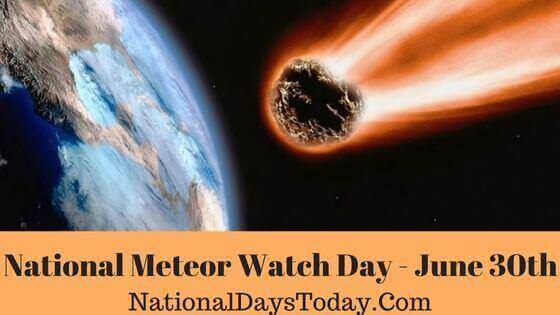National Meteor Watch Day
National Meteor Watch Day:
National Meteor Watch Day will be celebrated on every June 30th. It is a day to recognize the importance of observing and celebrating the beauty of the sky.
| Year | Date | Day | Where |
| 2023 | 30th June | Wednesday | United States |
| 2023 | 30th June | Friday | United States |
| 2025 | 30th June | Saturday | United States |
Twitter Hashtags:
#NationalMeteorWatchDay
#MeteorWatchDay
Related: Other National Days Celebrated on June 30th:
Why National Meteor Watch Day?
We need to celebrate National Meteor Watch Day to promote environmental awareness and give people a reason to get outside and enjoy the beautiful weather.
Planet Earth is our home, and we have been given a special responsibility to protect it.
This is a day to reflect on our responsibility to protect planet Earth and celebrate all the planet’s comets, meteors, asteroids, and other natural phenomena that can affect us.
We can make people aware that Earth has many exciting things to watch by celebrating this Day.
How Can We Observe National Meteor Watch Day?
It is a day to encourage people to observe the sky and look for meteor showers.
Some of the ways to celebrate this Day include:
- Take some pictures of the sky and post them on your social media accounts.
- Participate in a local event or watch a meteor shower.
- Take a picnic, go hiking, or go camping.
- Participate in a community event that involves the environment.
- Those who live in areas with a significant chance of seeing a meteor shower get outside and lookup.
- For those who live in areas where there is a slight chance of seeing a meteor shower, get outside and enjoy the beauty of nature.
- Those who don’t live in an area where meteors are likely, to enjoy the beauty of the night sky!
- Share your memories using hashtags like #nationalmeteorwatchday and #meteorday, and invite others to join in the celebration.
- Read About meteors on this Day. Explore meteoroid types and Go to a large field, Get a blanket and lie down on the ground to enjoy the meteoroids in the sky.
Interesting Facts About National Meteor Watch Day:
Let’s see some of the facts about This Day to explore more:
- Canada, the United Kingdom, and the United States are the first countries who celebrate this Day.
- The Day comes from a 19th-century tradition that encouraged people to spend a relaxing day looking for and watching meteors. Today, the tradition continues with people caring for meteor showers.
- According to the World Meteorological Organization, This Day is an International Day of Awareness and recognition of the importance of meteorology. It is held on the first Saturday of every May. It was first held in the year 2000.
- The Day was created in 1997 by the National Oceanic and Atmospheric Administration (NOAA) and the Federal Aviation Administration (FAA) to recognize the contributions of meteorologists and the importance of weather data to aviation safety.
- It was first observed in 1999 when over five million people in the US and Canada watched the moon pass in front of the sun.
- The American Meteor Society is a not-for-profit organization dedicated to promoting the study of meteorology and maintaining the National Meteor Watch.
- When they are between 34 and 70 miles above the Earth, they are usually visible. They vanish between 31 and 51 miles above the Earth’s surface. On average, their brightness lasts around one second.
- Since tiny meteoroids collide with the Earth’s atmosphere, we only observe a small number of meteors in the sky.
- Scientists have detected only 40 meteorite craters with diameters greater than 12 kilometers.
- Nearly 30 meteor showers are visible to Earth’s observers each year. Many of those showers had been in use for almost a century. For example, the Perseid meteor shower, which happens every August, was first witnessed roughly 2000 years ago and recorded in Chinese records.
History Of National Meteor Watch Day:
On July 4th, 1807, a famous meteor shower occurred, and it was dubbed the “Three Days of Darkness.”
The shower was so powerful that it could damage crops and livestock and spread panic
During that period, people started to wonder if there was a connection between the meteor shower and the recent eruption of Mount Tambora’s volcano in Indonesia.
As a result, some people started to refer to July 4th as National Meteor Watch Day; from that point on, people began to celebrate this Day as an opportunity to observe the sky and spot meteors.
Dr. Daniel Goldin, a NASA researcher, invented a network of weather stations to detect the first-ever meteorite impact on Earth in Antarctica.


